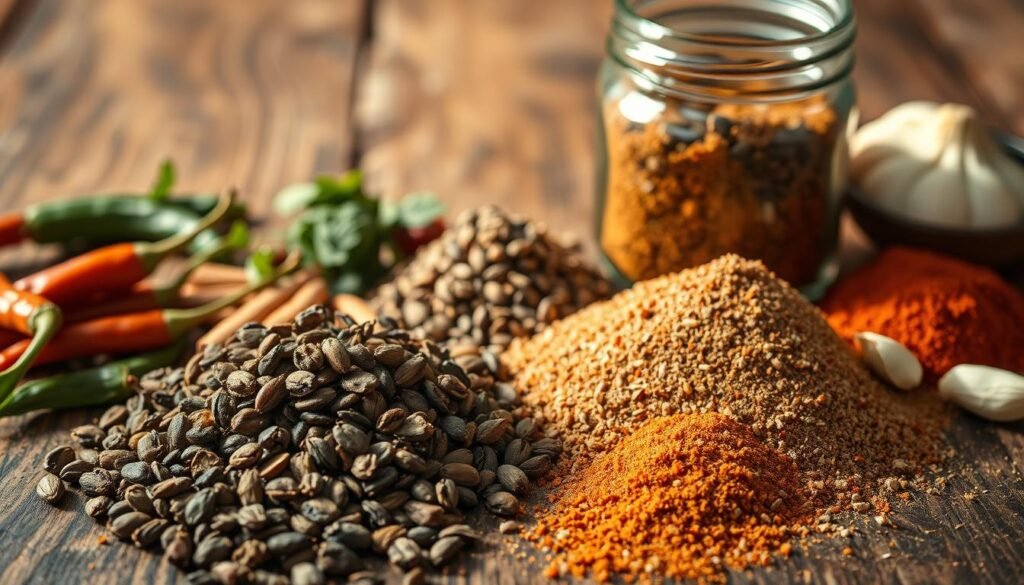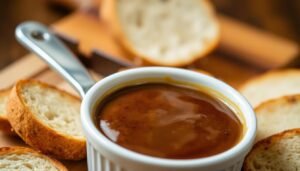Did you know a simple spice mix can turn a regular meal into a special dish? Homemade chili seasoning is a big help for anyone who loves to cook. I enjoy trying out new flavors, and I’m excited to share my quick and delicious chili seasoning recipe with you.
This seasoning blend is great for making your dishes better. It’s perfect for tacos inspired by al pastor or to add flavor to your favorite chili. Making your own chili seasoning means you can skip the preservatives and additives in store-bought mixes. This way, you get a healthier and tastier meal.
Key Takeaways
- Homemade chili seasoning is easy to make and customize.
- Avoid preservatives and additives found in store-bought mixes.
- Elevate your meals with a versatile seasoning blend.
- Perfect for various dishes, including tacos and chili.
- Make your cooking healthier and more flavorful.
Understanding Chili Seasoning Basics
Chili seasoning is a mix of spices that adds depth and warmth to food. It’s a key ingredient in many dishes, like chili con carne and al pastor recipes.
What Is Chili Seasoning?
Chili seasoning is a complex blend of spices. It usually includes chili peppers, garlic, cumin, and other spices. The mix can change based on the recipe or brand. Its main job is to add a rich, savory taste to food.
What makes chili seasoning great is its versatility. It’s not just for chili recipes. You can also use it in soups, marinades, and more.
Key Ingredients in Chili Seasoning
The main parts of chili seasoning can differ. But, you often find:
- Chili peppers or chili powder, which give the heat
- Cumin, adding a warm, earthy taste
- Garlic powder, making the dish savory
- Onion powder, adding to the depth
- Other spices like oregano, paprika, and sometimes cayenne pepper
Knowing these ingredients helps you see how complex chili seasoning is. It shows how it can boost your cooking.
The Benefits of Homemade Chili Seasoning
Homemade chili seasoning offers more than just taste. It’s about having control and using fresh ingredients. By making your own, you pick the quality and type of spices. This ensures your dishes are delicious and fit your dietary needs.
Freshness Over Store-Bought
Homemade chili seasoning is fresher than store-bought. Unlike mixes that sit for months, homemade is made fresh. This means your dishes taste more vibrant and appetizing.
When I made homemade chili seasoning, my kitchen filled with a wonderful aroma. It was a big difference from the stale smell of store-bought. This showed how important freshness is in cooking.
Customizable Flavor Profiles
With homemade chili seasoning, you can tailor the flavor to your liking. This is great for adjusting the seasoning in your favorite al pastor recipe. You can adjust the spices to get the perfect flavor.
| Spice | Store-Bought Mix | Homemade Mix |
|---|---|---|
| Chili Powder | Pre-mixed blend | Custom blend of ancho, guajillo, and chipotle peppers |
| Cumin | Standard amount | Adjustable to taste |
| Garlic Powder | Fixed proportion | Can be increased or decreased based on preference |
The table shows how homemade chili seasoning lets you customize. By changing the spice amounts, you can make a flavor that’s yours alone.
Essential Ingredients for Your Chili Seasoning Recipe
Making a great chili seasoning recipe starts with picking the best ingredients. A mix that balances flavors is crucial for delicious chili.
Common Spices for Chili Seasoning
Chili seasoning recipes often use a few key spices. These spices give the chili its main taste.
- Chili powder: This spice is the heart of chili seasoning, giving it its base flavor.
- Cumin: It adds a warm, earthy taste that’s typical of chili.
- Garlic powder: This spice makes the dish more savory.
- Onion powder: It adds depth to the flavor.
- Paprika: It brings a sweet and smoky flavor.
Together, these spices create a rich, complex taste that’s key to a great chili.
Optional Ingredients to Enhance Flavor
While the main spices are essential, you can also add optional ingredients to boost your chili’s flavor. Think about adding:
- Smoked paprika for a deeper, smokier taste.
- Cayenne pepper or red pepper flakes to change the heat level.
- Dried oregano for a bitter, earthy flavor.
- Coriander for a warm, citrusy taste.
These ingredients let you tailor the flavor to your taste, making your chili seasoning special.
Fresh vs. Dried Herbs
Herbs can be fresh or dried. Dried herbs are often used in chili seasoning because they last longer and pack more flavor. But, fresh herbs are good for making seasoning right before using it.
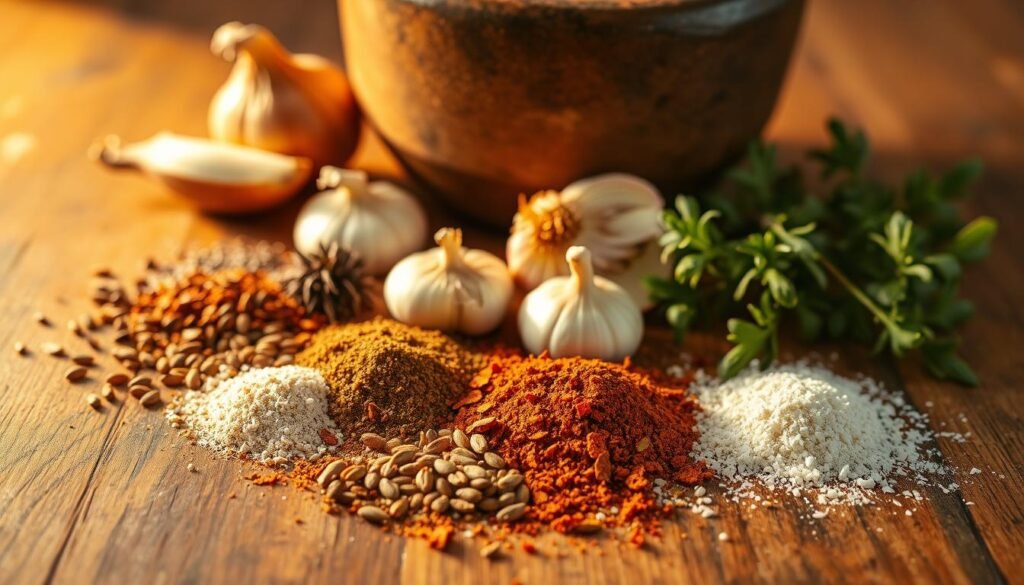
Whether to use fresh or dried herbs depends on what you like and the recipe. Some herbs, like cilantro, taste better fresh, so it’s best to use them then.
Step-by-Step Chili Seasoning Recipe
Making chili seasoning from scratch is easier than you think. I’m here to guide you through it. With a few simple steps, you can create a flavorful blend that will enhance your meals.
Measuring Your Ingredients
To start, you’ll need to measure out the ingredients accurately. This ensures that your chili seasoning has a balanced flavor. Use a digital scale for precision, as the proportions of the spices are crucial.
Here’s a simple table to help you with the proportions:
| Ingredient | Quantity (in teaspoons) |
|---|---|
| Chili Powder | 4 |
| Ground Cumin | 2 |
| Garlic Powder | 1 |
| Onion Powder | 1 |
| Paprika | 1 |
| Cayenne Pepper | 0.5 |
| Salt | 2 |
| Black Pepper | 1 |
Mixing and Storing Your Seasoning
Once you’ve measured out your ingredients, it’s time to mix them together. Use a bowl and a spoon to combine the spices thoroughly. Ensure the mixture is well blended so that the flavors are evenly distributed.
For storage, use an airtight container to keep your chili seasoning fresh. Store it in a cool, dry place, away from direct sunlight. This method is similar to how you might store spices for an al pastor recipe, emphasizing the importance of freshness.
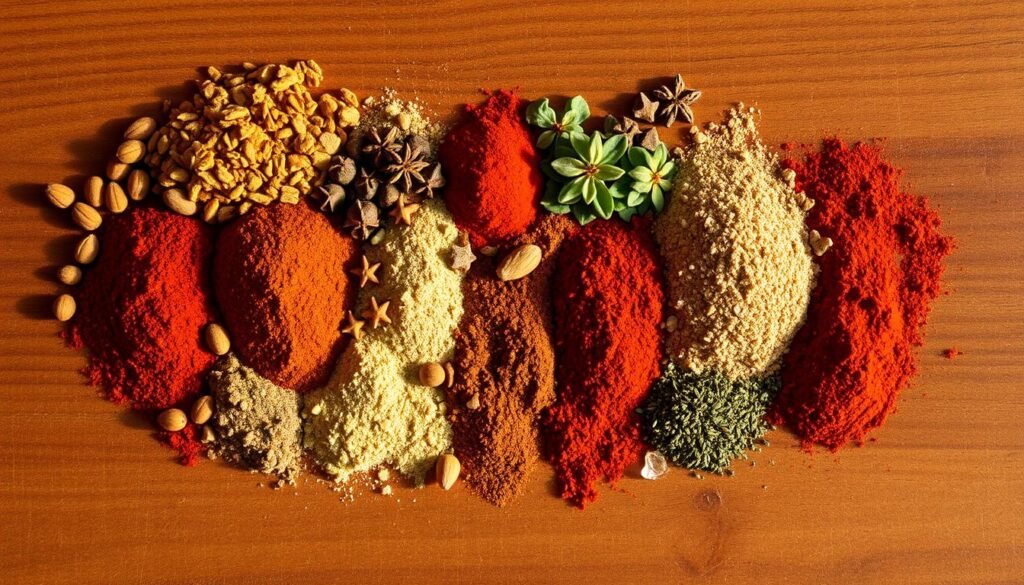
Tips for Adjusting Heat Levels
Heat level is key in chili seasoning. It can make or break the flavor. Knowing how to adjust heat can greatly improve your dishes.
Choosing the Right Peppers
The type of pepper you pick affects the heat. Ancho peppers are mild, while Habanero is very hot. For a milder taste, try Guajillo or New Mexico.
If you want more heat, use Cayenne or Scotch Bonnet. It’s all about finding the right mix for you.
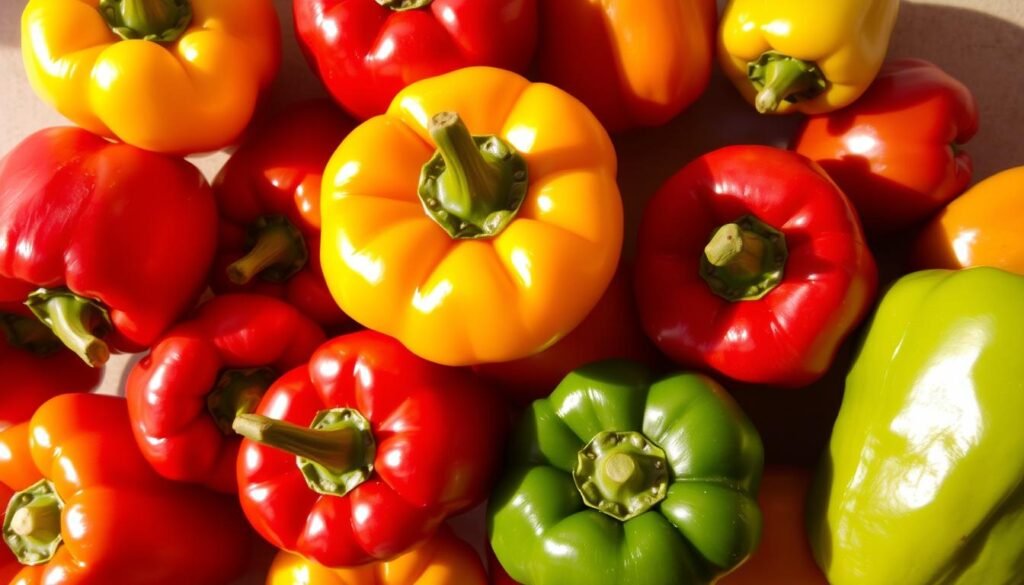
Balancing Heat with Sweetness
To balance heat, add a bit of sweetness. This works for chili and spicy dishes like al pastor. A touch of sugar or ingredients like cinnamon or cocoa powder can soften the heat.
For example, a bit of brown sugar can improve flavor and reduce heat. It’s about getting the heat right so it doesn’t overwhelm other tastes.
How to Use Chili Seasoning in Recipes
Your homemade chili seasoning is more than just a spice blend. It’s a key to unlocking flavorful dishes. You can use it to make a variety of meals, from hearty chilies to innovative fusion dishes.
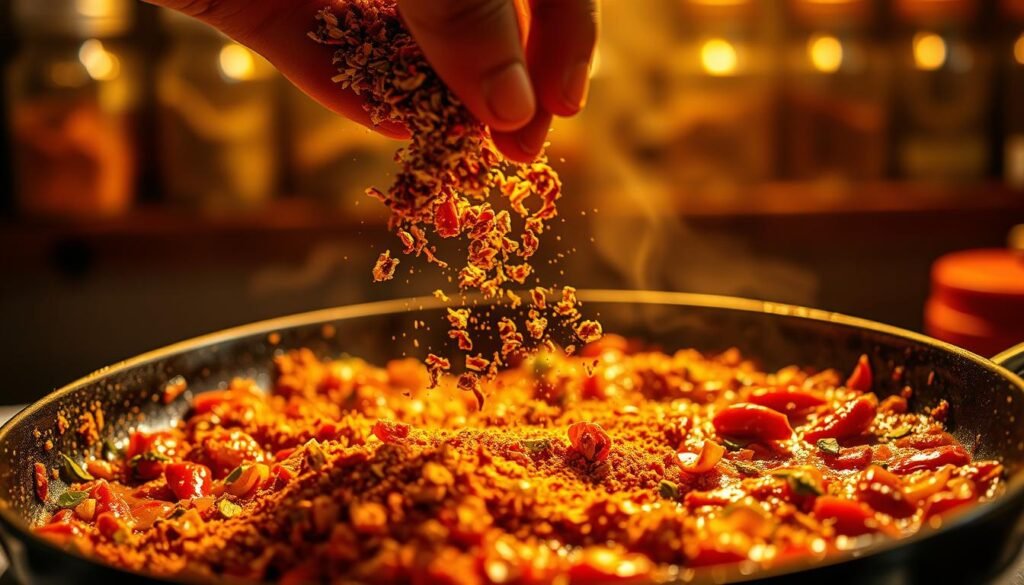
Chili Con Carne
The classic chili con carne is a staple for a reason. It’s a comforting, flavorful dish perfect for any occasion. To make it, brown some ground beef, add your chili seasoning, and simmer with canned tomatoes and beans.
For an extra depth of flavor, consider adding a splash of beer or a sprinkle of cocoa powder.
Veggie Chili Variations
Not all chili has to be meat-based. Veggie chili is a delicious and nutritious alternative. You can use a variety of beans, like kidney beans or black beans, and add in your favorite vegetables, like bell peppers or zucchini.
For a twist, try adding some roasted sweet potatoes or a can of diced tomatoes with green chilies.
Beyond Chili: Other Uses
Chili seasoning isn’t just for chili. It’s a versatile spice blend for various dishes, like tacos, stews, and soups. For example, use it to add flavor to your al pastor recipe or to spice up your roasted vegetables.
The possibilities are endless. So don’t be afraid to experiment and come up with your own unique recipe ideas.
By incorporating your homemade chili seasoning into your cooking, you’ll add flavor and a personal touch. Whether you’re making a classic chili or trying out a new recipe, your chili seasoning will become a staple in your kitchen.
Storing Your Chili Seasoning
How long your chili seasoning lasts depends on how you store it. Keeping it right helps keep the taste and smell. It also makes your homemade mix last longer.
There are a few key steps to store your chili seasoning well. First, use an airtight container. This keeps moisture and air out. I like using glass jars with tight lids for my spice mixes.
Best Practices for Longevity
To keep your chili seasoning fresh, follow these tips:
- Store it in a cool, dry spot, away from sunlight.
- Keep it away from heat, like ovens or stovetops.
- Use containers that seal tight to block air and moisture.
These steps help your chili seasoning last longer. Just like with an al pastor recipe, where fresh marinade is key, keeping your spice blend fresh is crucial for great taste.
How to Tell if Your Seasoning is Still Fresh
Spices can lose their strength and taste over time. Here’s how to check if your chili seasoning is still good:
| Check | Fresh | Not Fresh |
|---|---|---|
| Aroma | Strong, aromatic scent | Weak or no scent |
| Color | Vibrant, rich color | Faded or dull color |
| Flavor | Robust, characteristic flavor | Flat or off-flavor |
Spice experts say, “The freshness of spices depends on how you store and handle them.” Storing them right is essential for keeping your spice blends quality.
“The art of spice blending is not just about mixing ingredients, it’s about preserving their essence.”
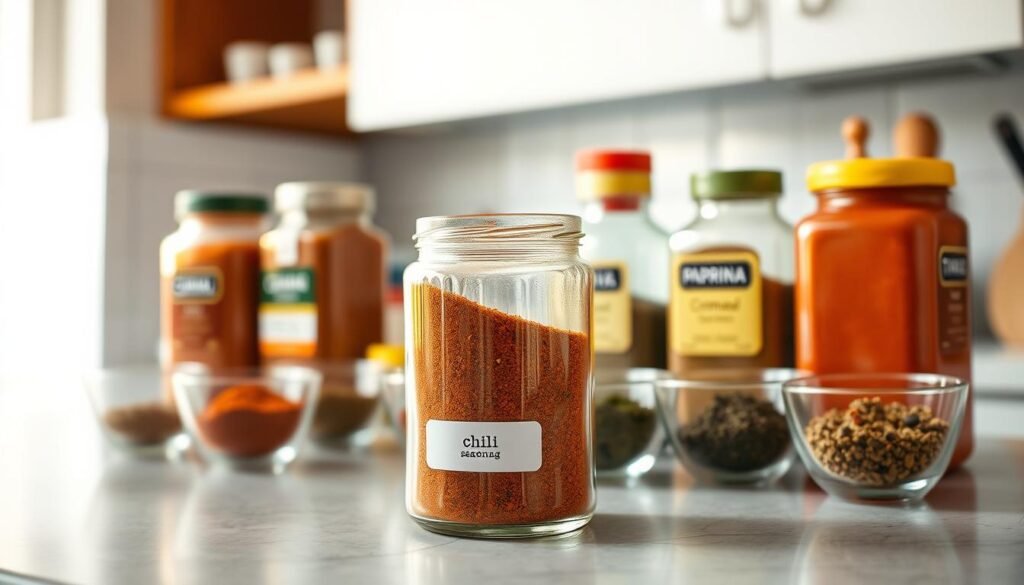
By storing your chili seasoning correctly and checking its freshness often, your dishes will stay flavorful and aromatic. Happy cooking!
Creative Variations on Chili Seasoning
There are endless ways to spice up chili seasoning. You can mix Southwestern flavors with Italian twists. I enjoy trying out new ingredients to make unique blends that make any dish better.
Southwestern Influences
The Southwest’s bold flavors can inspire your chili seasoning. Add cumin, smoked paprika, and a bit of lime zest. This mix reminds me of al pastor recipes, with their rich, complex taste.
Smoky Chipotle Variation
For a smoky heat, try chipotle peppers in your seasoning. Mix them with garlic powder and a bit of brown sugar. This blend adds a smoky depth to chili or as a meat rub.
Spicy Italian Twist
You can also give chili an Italian twist. Add Italian seasoning, fennel seeds, and red pepper flakes. This creative spice blend brings a Mediterranean taste to your dishes. It’s perfect for pasta sauces or roasted veggies.
These variations on chili seasoning are just the start. Don’t be afraid to try new herbs and spices. Whether for chili con carne, veggie chili, or other recipes, the fun is in experimenting with your spice blends.
Frequently Asked Questions About Chili Seasoning
When you start using your homemade chili seasoning, you might wonder about its shelf life and how to substitute ingredients. You might also be curious about its dietary compatibility. Let’s clear up these common questions. This way, you’ll feel confident using your chili seasoning, whether for a hearty chili con carne or trying out flavors inspired by al pastor.
Shelf Life of Chili Seasoning
Homemade chili seasoning can last 6 to 12 months if you store it right. Keep it in an airtight container, away from light and moisture. The best place for it is a cool, dark spot.
Substituting Ingredients
Yes, you can swap out ingredients in your chili seasoning recipe. This is great if you have specific tastes or dietary needs. For instance, if you want a gluten-free blend, just skip the gluten-containing ingredients.
Gluten-Free Considerations
Most chili seasoning blends are gluten-free, which is good for those with gluten issues. But, always double-check the ingredients of any store-bought parts, like chili peppers or spices. Make sure they haven’t been made in places that also handle gluten grains.

